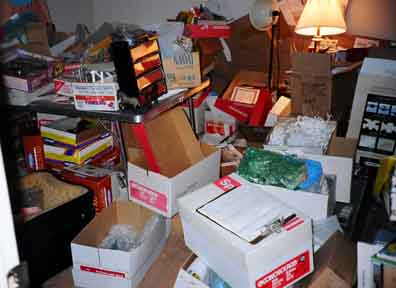
As time advances, a collector will often find their collection outgrowing the table, shelf, room, and/or house they've designated for displaying and storing their collection.
Some collectors have so much "stuff", they really can't "display" their collection and it stays (more compactly) in a closet or pile of boxes. That's disappointing, as it's really hard to share and enjoy the collection, especially after the time, energy, and effort to pursue a fun passion you want to share.
Or perhaps there's just a need to move things into storage for a time, such as redecorating.
Does this look like a room in your home?

So what are some options for finding/having enough storage and display space?
The options are to find "new" space or better utilize existing space.
Other considerations should include environmental concerns and ease of access. Model horses, especially plastic and customized pieces, are susceptible to heat and other environmental sources.
One "new" option is "off site" storage. Numerous organizations cater to the clutter-accumulators by renting anything from a small closet sized space to a warehouse on a monthly basis. Although the up front cost may be miniscule, say $1.00 the first month, the quantity of space used in storage and the duration of that usage accumulate into thousands of dollars. Recommended for "short" and near term (less than a year) storage due to rental cost. If such "long" term storage is needed, it might be better financially to dispose of the items and repurchase when needed. A similar option to the tradition storage facility is the new option of a portable storage unit delivered to your location, which is then filled, picked up and stored. Just remember that most storage facilities do not include transportation to/from your location, so borrowing a friend's van or truck or renting something might be required.
Another "new" option, for those who have a back yard (or other acreage) is to build a storage facility, anything from a plastic lean-to, to a full size metallic building. Resources such as land and a spouse's aesthetics in having such a building may put the kabosh on any such idea.
Found storage can include the garage, attic, or basement in your home (should you be fortunate to have such space). Obviously, it's usually easier to traverse stairs or run to the backyard than to the storage facility, for ease of access. But sometimes getting to those locations involves some physical contortion to get things in and out.
One other thing to consider for storage is the environment. Some facilities are susceptible to weather (including heat, cold) due to poor, little, or non-existent insulation, including all exterior facilities including many storage facilities and anything that would be in the yard, as well as attics and some garages. Basements may also be prone to ground water and/or flooding. Not to mention that mechanical equipment including boilers, water heaters, may cause issues with any environmentally sensitive items. Some pieces can even be damaged by prolonged exposure to direct sunlight.
A related environment storage issue is that the room/building an item is stored in may require a good circulation of air. Sealing external vents could cause condensation to build up inside the room/building and later "rain" down on the containers, possibly causing water damage. Even the container itself should not be "air tight" to allow for air circulation.
If stacking boxes, having a lower row of something that won't be affected by water (or something to "raise" the lowest row) is suggested. In addition, consider loosely placing a tarp or other waterproof surface on the top to help with any water from above.
When thinking about display space, having a good idea of the size and number of items desired to display is very helpful (and having an up to date inventory is never a bad idea either).
Options that model horse folk have used in the past for displaying their collection include:
Having enclosed display area minimizes the dusting that may have to be done, as well as helping to keep out the four (and sometimes two) legged creatures that we share our home with.
Having adjustability is often the best way to avoid "wasting" vertical space that might otherwise be used for another shelf.
The ability to illuminate the display unit is also a nice feature. Do consider that many light sources generate heat - that dreaded enemy - so be careful of the position of the light in relative position to the pieces on display and ensure that the heat can be properly dissipated.
![]() Back up to Library
Back up to Library
![]() Return to the Model Horse Gallery Home Page
Return to the Model Horse Gallery Home Page
This page maintained by the Model Horse Gallery Curator ©1996-2020